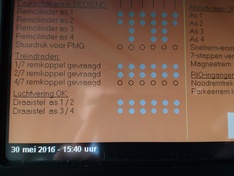ryan125hst
Established Member
Having enjoyed looking at some photos of loco hauled trains in the BR Blue era of the 70's and 80's over the last couple of days (all before my time sadly- if only it were possible to go back in time so I can experience those days!), I started looking into a few technical aspects, being the technically minded person I am. One such thing was the brakes and, surprisingly, the answer to my question can't be found online or by watching videos as I thought it would be.
From what I can gather, modern DMU and EMU traians use the EP (or electro-pneumatic) brake which allows the brake to be applied and released faster and allows the brake to be applied along the train at the same time. Loco hauled trains, however, such as the Deltics and Class 47 features in the photographs on Flickr that I found, would have had the two pipe air brake. This was better than a one pipe system as the auxiliary reservoirs on the train are filled from the main reservoir pipe, meaning that the auxiliary reservoirs on each carriage are filled faster so there is no risk of them running out of air and leaving the train without brakes.
One downside to the air brake system compared to the older vacuum brakes, from what I have read, is the lack of ability to partially release them. You can partially apply them, but to release them requires a full release. EP brakes don't have this issue, but the old system is overlaid and used in the event of a EP failure from what I understand (please correct me if I am wrong).
The question I have is was this lack of a partial release present on the loco hauled trains of the 70's and 80's? If that is the case, could someone explain the technique of braking, say, an 11 coach train on the ECML to a stand at a platform. I understand that brake controllers would have had the positions: Release, Running, Lap, Initial, Service, Full Service and Emergency. Would full service have been selected to reduce speed initial before releasing the brakes and selecting a lower brake rate to ease the train into the station? Or would a lower brake position normally have been used (I think it can be increased continuously between initial and full service?).
Finally, both videos I have seen mention reducing the brake shortly before the train stops, either by releasing the brake on an EPB, or by reducing to step 1 on a Class 321, as this removes the jolt that would be felt by passengers otherwise as the brakes are releasing as the train comes to a stop. The brakes are obviously then reapplied to keep the train at a stand. Would a similar technique have been used on loco hauled trains or would it have taken too long or the brakes to respond, particularly on long trains of 11 coaches or more?
From what I can gather, modern DMU and EMU traians use the EP (or electro-pneumatic) brake which allows the brake to be applied and released faster and allows the brake to be applied along the train at the same time. Loco hauled trains, however, such as the Deltics and Class 47 features in the photographs on Flickr that I found, would have had the two pipe air brake. This was better than a one pipe system as the auxiliary reservoirs on the train are filled from the main reservoir pipe, meaning that the auxiliary reservoirs on each carriage are filled faster so there is no risk of them running out of air and leaving the train without brakes.
One downside to the air brake system compared to the older vacuum brakes, from what I have read, is the lack of ability to partially release them. You can partially apply them, but to release them requires a full release. EP brakes don't have this issue, but the old system is overlaid and used in the event of a EP failure from what I understand (please correct me if I am wrong).
The question I have is was this lack of a partial release present on the loco hauled trains of the 70's and 80's? If that is the case, could someone explain the technique of braking, say, an 11 coach train on the ECML to a stand at a platform. I understand that brake controllers would have had the positions: Release, Running, Lap, Initial, Service, Full Service and Emergency. Would full service have been selected to reduce speed initial before releasing the brakes and selecting a lower brake rate to ease the train into the station? Or would a lower brake position normally have been used (I think it can be increased continuously between initial and full service?).
Finally, both videos I have seen mention reducing the brake shortly before the train stops, either by releasing the brake on an EPB, or by reducing to step 1 on a Class 321, as this removes the jolt that would be felt by passengers otherwise as the brakes are releasing as the train comes to a stop. The brakes are obviously then reapplied to keep the train at a stand. Would a similar technique have been used on loco hauled trains or would it have taken too long or the brakes to respond, particularly on long trains of 11 coaches or more?








